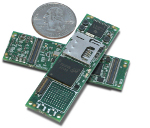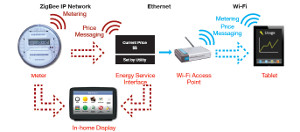The Bluetooth Special Interest Group has recently announced the publication of the Bluetooth 4.1 Specification with some interesting improvements to the standard, which greatly increase the usability of this wireless technology in devices for the “Internet of Things”, which offers new applications that allow such devices to serve as both hub and peripheral devices.
This paves the way for Bluetooth 4.1-enabled devices such as sensors to connect directly to the Internet. It also allows devices such as fitness dataloggers and headsets to collate data from sensors such as temperature sensors and heart rate monitors over Bluetooth networks then report back to a smartphone or tablet with their collected data. In turn, those devices could be used as sensors that other devices can communicate with and pull data from.
This new profile is the first major update of the Bluetooth specification since version 4.0 was released in 2010, including the Low Energy specification, a subset of version 4.0. The version 4.1 updates are all software related, so it is possible for over-the-air firmware updates to upgrade existing Bluetooth 4.0 systems with new firmware, with no hardware changes or replacement, to make them Bluetooth 4.1 compatible.
Bluetooth 4.1 adds support for bulk data transfers at higher data rates, so that information collected from sensors over a period of time can be downloaded in bulk from multiple sensors. Bluetooth is still a low data-rate protocol compared to, say, Wi-Fi or Ethernet, but as Bluetooth is expected to handle ever-larger streams of data from embedded sensors this is a useful improvement – downloading data from sensors to a datalogging appliance might take, say, a few seconds instead of 10 or 20 for existing systems.
Bluetooth 4.1 allows Bluetooth devices to act as both a peripheral device and a hub at the same time, allowing a Bluetooth device that may have previously been networked with a smartphone or tablet to itself act as hub for other Bluetooth peripheral devices.
For example, your Bluetooth 4.1 enabled smart watch might be able to grab weight information logged from a Bluetooth-enabled scale and display it for you as well as being able to pass that data along to a smartphone. Bluetooth 4.1 also adds improvements to the sleep-wake cycle of the Bluetooth radio, allowing Bluetooth devices to automatically connect more easily (if allowed) without manual intervention.
Another example could be a bathroom scale that can automatically connect and download the distance walked from your Bluetooth-enabled pedometer or exercise tracker when you walk into the bathroom.
Bluetooth 4.1 improves coexistence between Bluetooth devices and 4G Long Term Evolution (4G LTE) cellular devices, to prevent potential interference. Although this is not a significant problem for Bluetooth 4.0 devices today this was considered to be a potential problem in future as more and more Bluetooth 4.0 devices are in use, talking to 4G connected smart-phones or tablets.
The new specification also increases the time-out period between devices, so that removing a Bluetooth device (such as your phone, for example) outside the proximity of another Bluetooth device it is connected to for a short moment and then back again may not mean that the Bluetooth connection has to be reconnected, improving user experience.
Furthermore it also lays the groundwork for IP-based connections between Bluetooth devices, in the same way a Wi-Fi router connects to multiple Wi-Fi devices, giving Bluetooth devices a way to talk directly to the Internet. Plus version 4.1 adds a standardised way to create a dedicated channel which could be used for IPv6 communications over Bluetooth in the future, enabling the possibility of native IPv6 networking from the Internet down to the LAN right down to wireless sensor nodes, in a similar way to how 6LoWPAN enables this type of connectivity for 802.15.4 wireless networks.
However, adding IPv6 connectivity to Bluetooth devices may substantially increase the power budget of battery-operated devices, especially Bluetooth Low Energy devices designed for extreme power efficiency, so this may not be an appropriate choice in all cases.
Such Internet connectivity directly to Bluetooth devices opens up interesting potential for the future development of Bluetooth, for example phone calls made over VoIP directly to a person’s Bluetooth headset, or the remote viewing of health data from medical sensor devices by healthcare professionals.
These improvements to the Bluetooth standard, such as IPv6 support, the ability to act as a hub instead of only as a peripheral, better radio sleep-wake cycles, timeout changes and improved data rates make Bluetooth 4.1 easier to use in the development of networks of wireless, power-efficient networked devices that aren’t intended to always be paired directly to a single Bluetooth enabled smartphone or tablet – in other words, Internet-of-Things networks and devices.
As you have just read, the new Bluetooth profile offers a great amount of promise in terms of functionality and convenience for the end user. Here at the LX Group our engineers have an excellent understanding of many wireless platforms – including Bluetooth – and are ready to integrate it with your new and existing products.
To get started, join us for a confidential discussion about your ideas and how we can help bring them to life – click here to contact us, or telephone 1800 810 124.
LX is an award-winning electronics design company based in Sydney, Australia. LX services include full turnkey design, electronics, hardware, software and firmware design. LX specialises in embedded systems and wireless technologies design. https://lx-group.com.au
Published by LX Pty Ltd for itself and the LX Group of companies, including LX Design House, LX Solutions and LX Consulting, LX Innovations.


